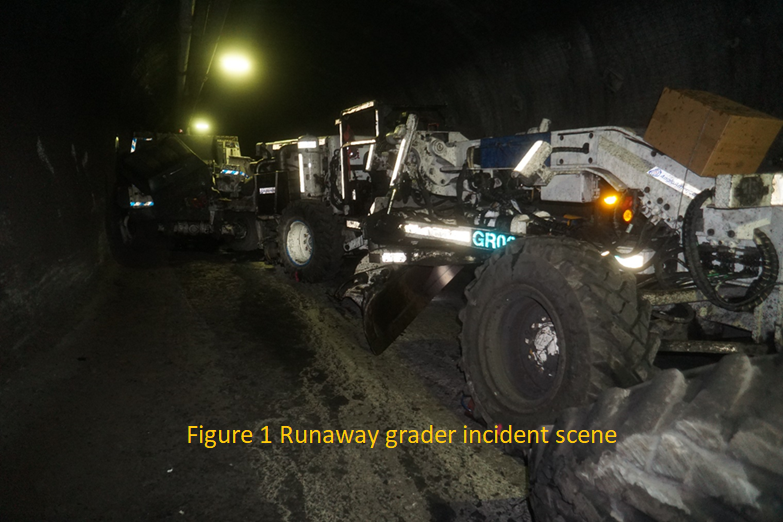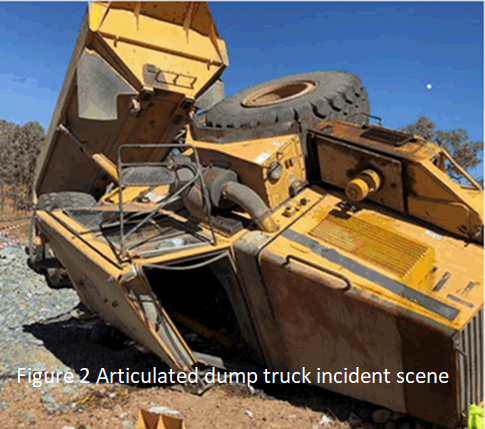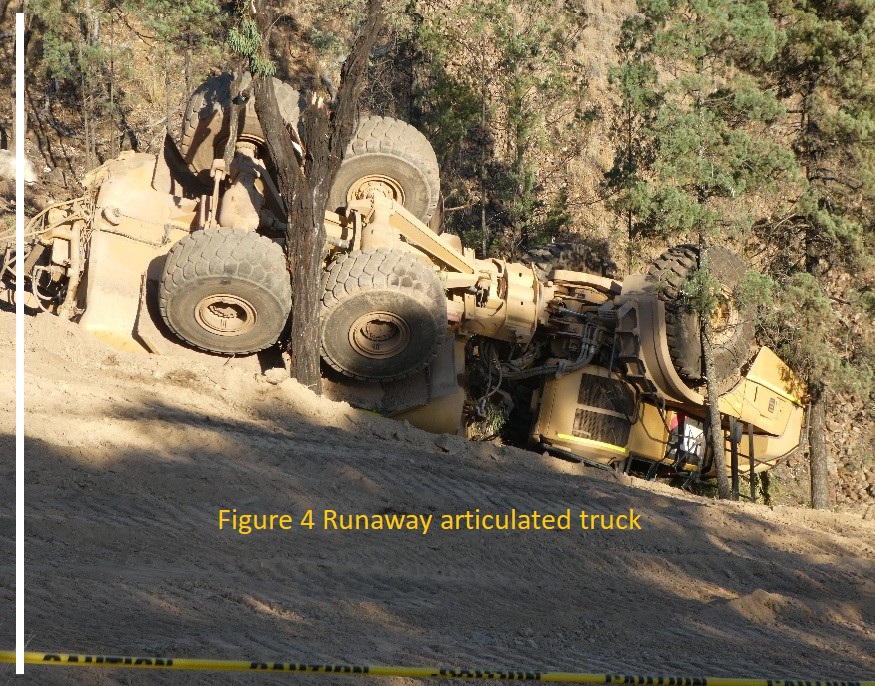
Mines safety bulletin no. 182 | 20 May 2019 | Version 1
Engineering and maintenance of mobile plant braking systems
Background
The purpose of this safety bulletin is to provide information on investigations by the Mines Inspectorate where deficiencies in engineering and maintenance of mobile plant braking systems have contributed to incidents. It is expected that implementation of recommendations will reduce the risk of braking system failures.
Incident summaries
Fatality involving runaway grader
A collision occurred between a runaway grader and a personnel carrier in the men and materials drift of an underground coal mine (refer Figure 1).
The grader operator was fatally injured and four coal mine workers were hospitalised. Investigations into the incident are ongoing.
Fatality involving an articulated dump truck
A laden articulated dump truck was descending a quarry access ramp when it appears that the worker lost control of the vehicle.
At the bottom of the ramp the vehicle overturned, partially pinning the worker under the cab (refer Figure 2). He later succumbed to his injuries.
Serious injury involving a runaway rear dump truck
Whilst dumping a load, a rear dump truck travelled backward to the crest of the pit wall and then fell approximately 15 metres coming to rest on the pit floor (refer Figure 3).
During the incident the operator either experienced or perceived to experience a service brake failure. The operator suffered multiple serious injuries including spinal and rib fractures
Serious injury associated with a runaway articulated water cart
A loaded articulated water cart was ascending a ramp on a mine’s tailings dam. The engine stalled for unknown reasons and the vehicle ran away backwards down the face of the tailings dam wall, overturning at the bottom and pinning the operator in the cab (refer Figure 4).
The operator reported that the vehicle had no brakes.
Comments
- These incidents resulted in fatalities and serious injury to workers.
- Further information on braking system safety is available in safety bulletins previously published by the Mines Inspectorate (References 1, 2, 3 & 4) and equipment suppliers.
- Investigations of the incidents have identified multiple contributing factors. However, several factors relating to braking system engineering and maintenance have been identified.
Note: Not all contributing factors relate to all incidents or investigations. - Contributing factors specifically related to braking systems include:
- Pre-start checks:
- Pre-start checks and findings not documented.
- Safety critical components such as system accumulator pressures not checked prior to equipment use.
- Defect management:
- No formal system in place to record defects, actions taken to address defects or communicate actions to workers.
- Plant continuing to be operated with known defective braking systems.
- Foreseeable events:
- The shutdown of the vehicle engine renders the steering system very difficult to operate and hydraulically operated implements, including access components, may not be able to be lowered to ground level. Mine procedures for safe parking, particularly on grades, may not be able to be complied with in such situations.
- Maintenance systems:
- Maintenance and operations manuals not readily available to operators or maintainers.
- Recommended OEM maintenance checks on brake systems not being completed.
- Brake system components:
- Accumulators in braking circuits have been found to be defective.
- Air separators bypassed.
- Air circuit check valves inoperable and not installed in the correct orientation.
- Brake system air leaks resulting in defective brakes.
- Operation of brake circuit components relying on specific sequencing and timing found to not be within specification. This may have resulted in undetected worn and inoperable braking components.
- Modifications to brake circuits:
- Brake circuit integrity significantly affected by small seemingly insignificant hose/circuit changes such as bypassing what is effectively a critical component.
- Consequence of failed components in the brake system:
- A failed check valve allowed bidirectional flow in and out of the service brake circuit. This didn’t adversely affect the service brake until an air leak external to the service brake drained air from the service brakes rendering them inoperable.
- Inadequately pressurised brake system accumulators could not provide sufficient system pressure for effective braking when the engine stalled.
- Hidden failures:
- Test procedures not actually testing the circuit or critical parts of the brake circuit masking failed components.
- An investigation found that the tests carried out to check the park brake in fact only checked the service brake.
- Version control of technical information:
- Brake circuits not updated to the latest OEM or approved brake system design. A safety critical upgrade appeared to have not been implemented.
- Pre-start checks:
Recommendations
Mines should:
- Review procedures for the introduction of plant to site. Ensuring that current operating, maintenance and service manuals are available to workers, and confirming safety bulletins issued relevant to mobile plant have been reviewed and addressed.
- Review brake system designs, associated risk assessments, failure modes and effects analyses and test procedures ensuring the installed systems are robust and reliable.
- Validate all braking systems on each piece of mobile plant to ensure they comply with latest OEM specifications or approved designs for the particular piece of plant.
- Review Standard Operating Procedures for testing and maintaining the effectiveness of braking systems on fixed and mobile plant.
- Review the adequacy of maintenance plans, including procedures for the assessment of the condition of critical components such as check valves, accumulators, sequence valves, internal multi-disc brakes etc.
- Ensure maintenance systems are in place and effective and auditing of maintenance work is carried out to ensure acceptable standards of work are being undertaken.
- Review training schemes and the competence of workers undertaking work on brake systems.
- Review training schemes for vehicle operators to ensure they understand each of the braking systems installed on mobile plant they operate and their operation under foreseeable circumstances.
References
- Serious accident involving an articulated water cart. Safety Alert No. 361, issued 10/1/2019
- Fatality involving and articulated dump truck. Safety Alert No. 358, issued 10/12/2018
- Uncontrolled engine shutdown on 777 dump truck. Safety Alert No.327, issued 18/06/2016
- Heavy rigid truck runaways on the increase. Safety Alert No. 295, issued 16/10/2012
Contact: Anthony Logan, Senior Inspector of Mines , +61 7 3199 8013 anthony.logan@dnrme.qld.gov.au
Issued by Queensland Department of Natural Resources, Mines and Energy
Find more safety notices
Search the hazards database



